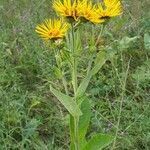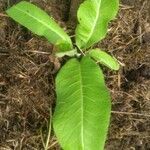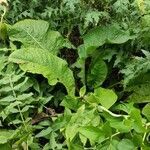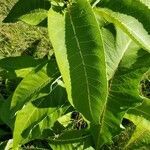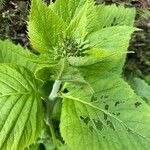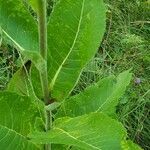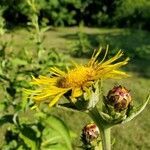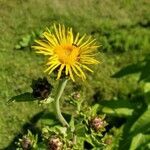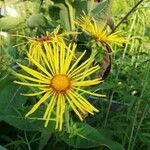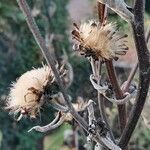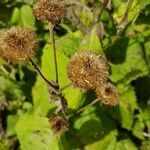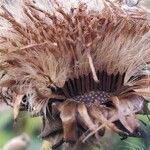Plants 50–100(–200) cm. Leaves: basal blades ± elliptic, mostly 15–40 cm × 100–200+ mm (bases decurrent onto strongly ribbed petioles, margins callose-denticulate, otherwise entire, abaxial faces velvety-woolly, adaxial thinly hairy); cauline blades ovate or elliptic to lanceolate, 10–30 cm × 45–120 mm, bases cordate, clasping, margins serrate. Involucres (20–)30–40 mm diam. Outer phyllaries ovate, oblong, or ± deltate to lanceolate, 12–20(–25+) × 6–8(–20+) mm (abaxially velvety-hairy); inner phyllaries progressively narrower, less hairy, more scarious. Ray florets (15–)50–100+; corolla laminae (10–)20–30+ mm. Disc corollas 9–11 mm. Cypselae 3–4 mm, glabrous; pappi of (40–)50–60 basally connate, barbellate bristles or setiform scales 6–10 mm. 2n = 20.
Coarse perennial herb to 2 m, the stem finely spreading-hairy; lvs irregularly and shallowly dentate, densely velvety-woolly beneath, sparsely spreading-hairy or subglabrous above, the lower long-petiolate and elliptic, with blade to 5 × 2 dm, the upper becoming ovate, sessile and cordate-clasping; heads few, pedunculate, large, the disk 3–5 cm wide, the invol 2–2.5 cm; outer bracts broad, herbaceous, densely short-hairy; inner bracts narrow, subscarious, glabrous; rays numerous, slender, 1.5–2.5 cm; achenes glabrous, columnar and ± distinctly quadrangular, multistriate; pappus-bristles united at base, often in groups; 2n=20. Intr. from Europe; cult., escaped, and sparingly naturalized in moist or wet disturbed sites. May–Aug.
Erect, rhizomatous, perennial, up to c. 2 m tall. Stems densely hairy, branched above to form infl. Lower cauline lvs sparsely to moderately hairy on upper surface, tomentose on lower, ovate-elliptic, petiolate and cuneate, acute, finely denticulate, up to c. 60 × 20 cm; upper lvs similar but smaller, apetiolate and usually amplexicaul. Capitula 6-9-(13) cm diam., few in corymbs. Outer involucral bracts tomentose, herbaceous, ovate, 10-15-(30) mm long; inner bracts glabrous or tomentose only on lamina, membranous, 15-25 mm long. Ray florets numerous; ligules yellow, c. 2-3-(5) cm long. Disc yellow. Achenes glabrous, 4-5-angled with faces finely ribbed, 3.5-5 mm long; pappus minutely barbellate, fused at base.
It grows 2.4-3 m high. It spreads 0.9-1.2 m wide. The leaves are large and oval. They have teeth and are wrinkled. They are downy underneath. The lower leaves can be 70 cm long. The flowers are yellow. They are produced in heads at the top of the plant. They are 8 cm across.
